A question that has been asked regularly or a debate that happens quite often is Canon vs Nikon. Although there are amazing cameras in the digital camera industry besides Canons and Nikons, some that can even outperform certain features of these two manufacturers, the talk about choosing between the two camera brands, Canon and Nikon gear hasn't ended yet.

A fact that we all need to know is that both companies manufacture excellent camera bodies and lenses and if there is something that should make a user select one over the other then it will be down to something that feels good on their hands, budget or suits their specific needs. Both Nikon and Canon have a decent range of DSLRs and mirrorless cameras in both the APS-C and full frame range and choosing the first camera can be tricky.
You need to be very careful with the choice you make because you will be buying a camera, then lenses and compatible accessories, which means you may be sticking with that brand for many years, unless you decide to sell everything later and move on to some other brand.
Here are some factors to look into before buying a camera:
Budget
If you are someone who is looking for your first DSLR or mirrorless camera, keep your budget in mind and then visit a camera store to see the range of cameras that fit closely within your budget. Both Canon and Nikon offer entry level affordable cameras at a price range which can be less than $500. What you could do is check out both cameras to see how they feel in your hands, how user-friendly the menu and other features are and which one has better features for a particular price range and your needs.
Canon and Nikon also keep their old range of cameras for a while before they are discontinued. Moreover, you will also be able to bag a good discount or other offers in older models when new models in the series are launched.
Menu
Terminologies
Terminologies are quite different when it comes to Canon and Nikon. Nikon uses simpler, straightforward and easy to remember terminologies that are easier for beginners to understand.
For example, when you look at the mode dial, S stands for Shutter Priority in Nikon Cameras whereas Tv stands for Shutter priority on a Canon camera. Similarly, where Nikon uses the terminology Continuous AF, Canon uses the term AI Servo. These can be a bit confusing for beginners who are just getting used to their cameras.
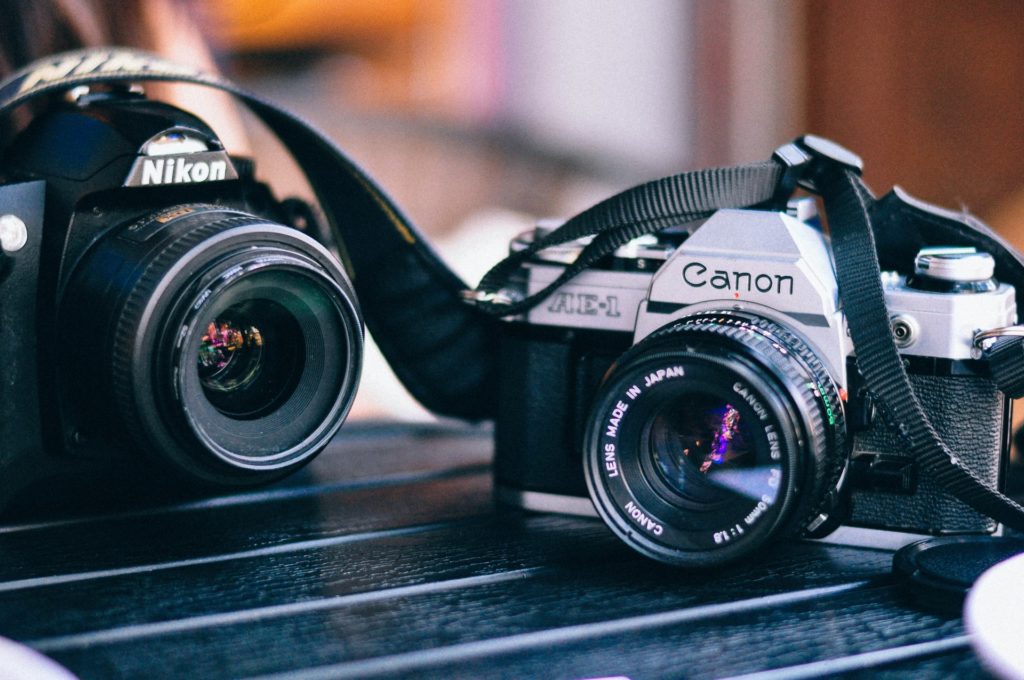
In general, Nikon and Canon have a huge range of cameras starting from compact cameras, DSLR and mirrorless cameras and other accessories and lenses. Nikon has a few underwater cameras in their compact camera range. This article discusses similar cameras and the features for both Nikon and Canon and the thoughts on which one could be better for a particular expertise or price range.
Entry Level Cameras
When it comes to entry level cameras, both manufacturers have a bunch of models that you can choose from with new models being released almost every year. But there are also older models that you can go for at a cheaper price if you are just beginning with photography.
Some affordable entry level cameras from both manufacturers are below:
Canon: Canon EOS 4000D, Canon EOS 2000D, Canon EOS 250D

The Canon EOS 4000D has an 18mp APS-C sensor, 9 point AF system and can shoot only at 3 fps whereas the EOS 2000D comes with a 24.1 mp sensor. Even advanced is the EOS 250D with a 24.1 mp sensor with dual pixel CMOS AF system and shoots at 5 fps. It comes with a vari-angle screen and has 9 AF points.
If you are able to spend a little more, then the Canon EOS 700D, 800D and 850D are good choices. The EOS 700D comes with an 18 mp sensor and is pretty cheap, but it is an older camera. If you are looking for a new camera, then you should think about saving up and spending a bit more.
Nikon: Nikon D3400 and Nikon D3500

Both the D3400 and D3500 come with 24.2 mp sensor, can shoot at 5 fps and come with 11 AF points. The sensor of D3500 is new and comes with a slightly larger handgrip. Also the battery life for D3500 is more compared to D3400 – almost 1500+ shots compared to only 1200 for D3400.
If you are looking for slightly better cameras they are a bit more expensive, and you should check out the D5600. It comes with a 24.2 mp sensor, a fully articulating screen, 39 autofocus points and produces sharp images.
Thoughts
The cheapest model of Canon's entry level camera the EOS 4000D is more affordable compared to Nikon's cheapest camera, but you need to compromise on the sensor resolution, lens mount, small LCD displays, battery life, burst rate and a few other features. It would be better saving up and investing in a slightly better camera if possible.
Mid Range Cameras
If you have a bit more money that you can invest in a camera, then you should be looking at buying one of the mid range cameras so you do not have to upgrade again in a few months or a year.
Canon and Nikon provide cameras in the mid range if you are looking for cameras with advanced features or you’re planning to upgrade to an advance crop sensor camera, but are not yet ready to upgrade to full frame cameras.
Canon: Canon EOS 90D

The Canon EOS 90D comes with a 32.5 mp sensor, comes with a fully articulating touchscreen and has a dual pixel CMOS AF system that helps with continuous focus while shooting stills and movies. It also features a 45 cross-type point autofocus system and can shoot at 10 fps. The image quality is very good and can control noise pretty well.
Nikon: Nikon D7500

The Nikon D7500 is one of the best cameras packed with amazing features and it comes with 51 point AF system, 8 fps and a 20.9 mp sensor.
Thoughts
Being the newer camera of the two, the Canon EOS 90D is more expensive and has some of the features of high end cameras. The D7500 is not too bad comparatively with similar specifications and is best suited for low light shooting, good image quality and battery life.
High End Pro Level Cameras
When it comes to pro level cameras, both the manufacturers have them in the APS-C and full frame range. Here is what they have to offer.
APS-C Cameras
Anyone who is looking to shoot action and wildlife can go for the APS-C cameras with pro level features that are offered by both Canon and Nikon.
Canon: Canon EOS 7D Mark II
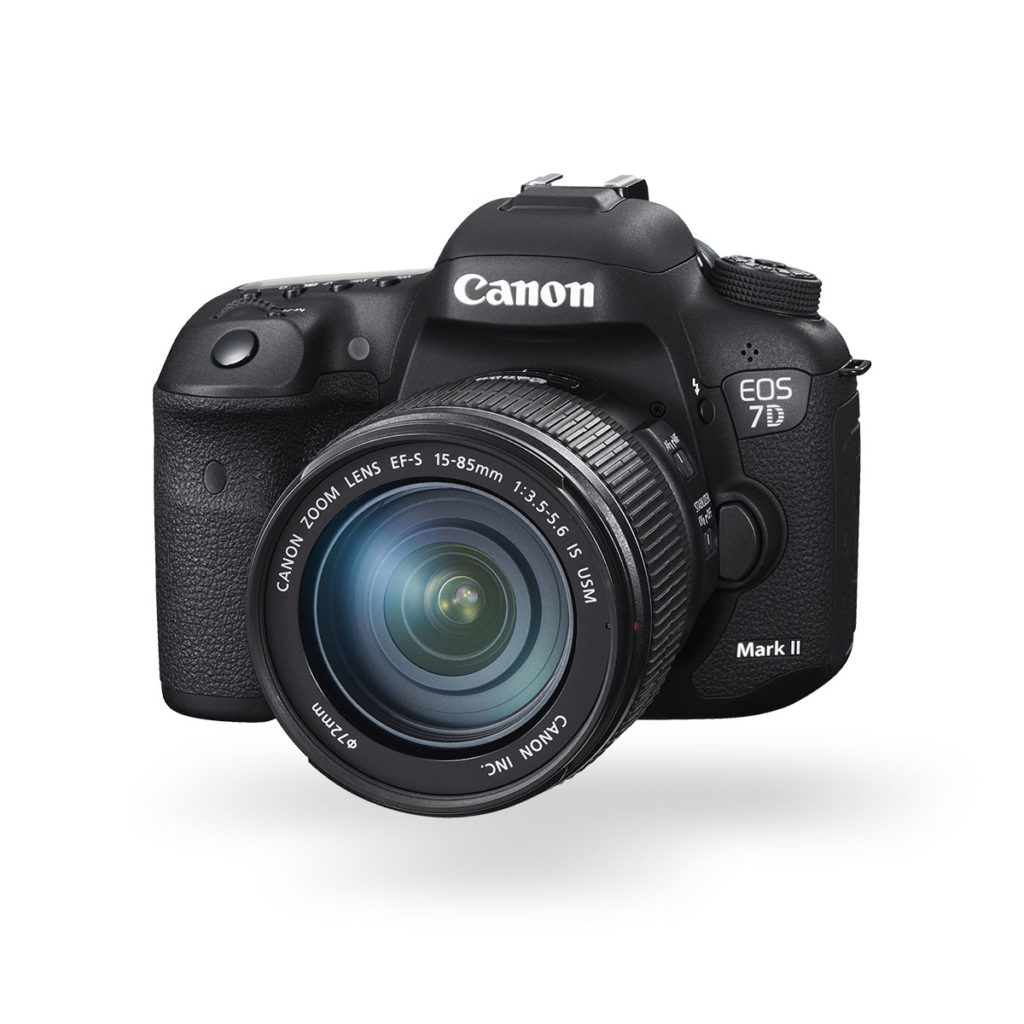
The Canon EOS 7D Mark II has a 20.2 mp sensor and comes with an anti-aliasing filter. It has a 65 point all cross type AF system, shoots at 10 fps (up to 31 raw files), 4K video recording and a tiltable touch screen.
Nikon: Nikon D500

The Nikon D500 outperforms the Canon EOS 7D Mark II in many areas where it comes with a 20.9 mp sensor and lacks the anti-aliasing filter which means it should be able to capture images with better detail. The camera comes with 153 points AF system with 99 cross type points, can shoot at 10 fps (up to 200 raw files), broader iso range and a tiltable touch screen. The performance of D500 is excellent that if you were to choose between the Canon or the Nikon here, it should definitely be the Nikon.
Thoughts
Both cameras come at about the same price range, so there is no thinking about which one is affordable.
Full Frame Cameras
If you are looking to upgrade and are looking for affordable full frame cameras, there are some really good ones that Canon and Nikon camera company manufactures.
Canon: Canon EOS 6D Mark II
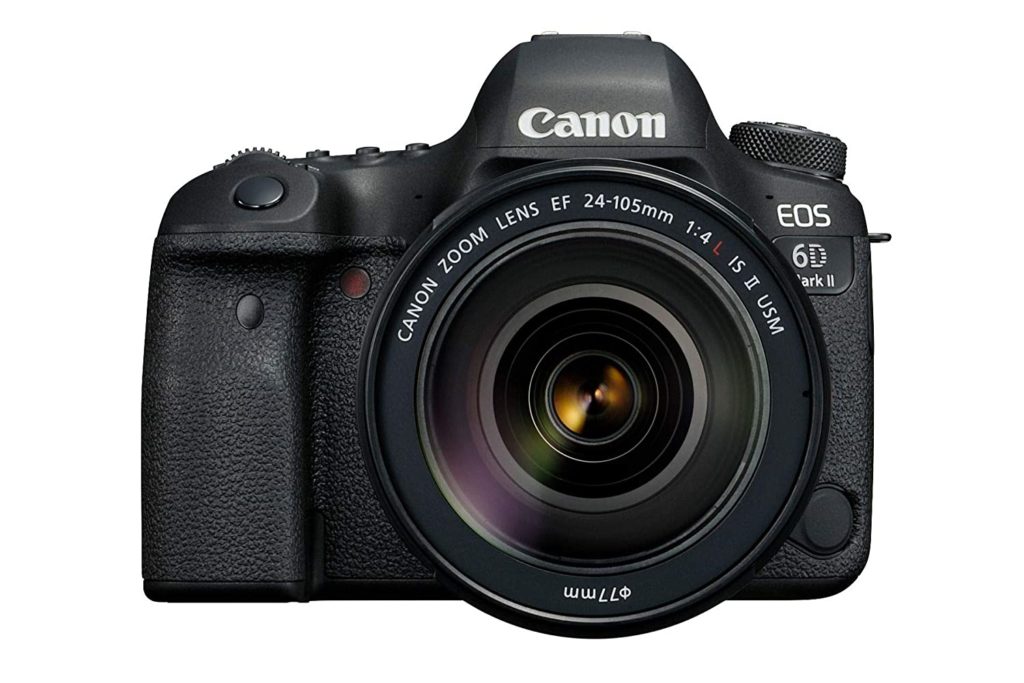
The Canon EOS 6D Mark II is a new one in the market and comes with 26.2 mp sensor, 45 point AF system, dual pixel CMOS AF system and a vari-angle touchscreen, 4K video shooting and only 6.5fps continuous shooting.
Nikon: Nikon D610 and Nikon D780

Nikon’s D610 and D780 are two of the best full frame cameras that you can go for without a second thought. The D610 comes with 39 point AF system with 11 cross type points and it is the cheapest full frame camera from Nikon. The D780 comes with a tilting screen, 51 AF points system with 15 cross type points, 7 fps shooting, Eye Af and a 24.5 mp sensor. It can handle low light pretty well and can be used to shoot videos. If you want similar features of the Nikon D780 and are looking for a slightly cheaper camera, the Nikon D750 is still available.
Thoughts
Comparing a Canon and Nikon camera of this range, the Nikon D780 seems to be a better camera in terms of performance and it is very new.
More High End Pro Level Full Frame Cameras
If you are upgrading and are willing to spend a large amount on a camera for professional work, then here are some options for you to consider. Again in this range, both the manufacturers have their own range of cameras. While the price can be hugely on the expensive side, the cameras come packed with amazing features and performance.
Canon: Canon EOS 5D Mark IV and Canon EOS 1D X Mark III

Canon: The EOS 5D Mark IV is an affordable camera and comes with a 30.4 mp sensor, has 61 point AF system and can shoot at 7 fps. It has Wi-Fi connectivity and the battery life is quite low.
The EOS 1D X Mark III is an expensive one and comes with a 20.1 mp sensor, has amazing burst mode of 16fps, faster shutter speed, precise and fast autofocus, good battery life and has wireless connection. It is one of the heaviest cameras in this range.
Nikon: Nikon D850 and Nikon D6

Nikon: The Nikon D850 is considered the best in this price range – an affordable one with a 45.7 mp sensor, incredible performance, 153 point AF system, can shoot at 7 fps and can be used for any genre of photography. It has WiFi connectivity and has better battery life compared to the Canon 5D Mark IV.
The Nikon D6 is quite expensive and comes with a powerful autofocus system, a 20.8 mp sensor, 14fps continuous shooting, iso expandable to 3,280,000 and supports 4K UHD. It is powered by EXPEED 6 processor, has brilliant low-light performance, noise suppression, image clarity and colour reproduction.
Thoughts
Comparing the EOS 5D Mark IV and Nikon D850, the sensor resolution for D850 is higher, it yields better images and has better battery life compared to Canon EOS 5D Mark IV. However the Nikon files can be very huge taking up too much space on the memory card and backup drives. The Canon is lighter and comes with Dual Pixel AF system.
Both the cameras perform well and have almost similar specifications when it comes to Canon EOS 1D X Mark III and the Nikon D6. The Canon has better continuous shooting mode.
Mirrorless Series
Canon and Nikon are the most famous when it comes to DSLRs but they have not just stopped with their DSLR range of cameras. They have in the recent years gone to manufacture their mirrorless range of cameras. So if you are looking for a mirrorless camera system, you have some good cameras to choose from.
Nikon and Canon have been quite late to the mirrorless market compared to Olympus, Panasonic and Sony but they have a lot to offer in this short period of time. Moreover, they have both APS-C and full frame ranges in their mirrorless series.
Nikon uses the Z mount for their mirrorless series that is different from the F mount in the Nikon DSLRs, but you can use an adapter to use the F mount Nikon lenses on their mirrorless cameras including manual focus lenses. Nikon uses the same Z mount for both their APS-C and full frame mirrorless series, so it is easier when you need to upgrade later.
If you are looking for an entry level mirrorless camera, both Canon and Nikon have their own range with a good range of Nikon and Canon lenses.
APS-C Mirrorless Cameras
Canon has a few cameras that you can choose from that come with good specifications and features but they use two different mounts for their APS-C (EF-M mount) and full frame (RF mount) series. These are completely different from their DSLR mount and the DSLR lenses can be used in the mirrorless cameras using an adapter.
Canon: Canon EOS M5, Canon EOS M6 Mark II, Canon EOS M50 and Canon EOS M200

The Canon APS-C mirrorless series are the Canon EOS M5, M6 Mark II, then the M50 and M200.
The EOS M5 comes with a viewfinder and has a flip LCD screen. It can shoot at 7.4 fps and comes with a Dual Pixel CMOS AF system. The EOS M50 is a better camera in terms of its new DIGIC 8 processing engine and comes with a better viewfinder and vari-angle LCD screen.
The EOS M200 is the smallest of the set and is aimed at vloggers and for photographers who want to travel light. It does not have a viewfinder, but has a forward facing LCD screen. The M6 Mark II comes with a 32.5 mp sensor, 4K video and 14fps continuous shooting mode and it does not have a built-in viewfinder.
Nikon: Nikon Z50

Nikon at the moment and has the Z50 in the APS-C range which is a good camera. If you are looking for a mirrorless camera to begin with, then this camera with its 20.9 mp sensor, 4K video recording, built-in viewfinder can be a good choice. It has specific lenses built for the small sensor and is relatively cheap.
Thoughts
When it comes to mirrorless APS-C series, the Nikon Z50 and the Canon M6 Mark II perform well, but for the Canon camera, you will need to attach an external viewfinder if you need and the Nikon Z50 is cheaper compared to the Canon EOS M6 Mark II.
High End Full Frame Mirrorless Cameras
The high end mirrorless cameras from Canon and Nikon were released around the same time and come with very advanced features and amazing performance.
Canon: Canon EOS R, Canon EOS RP, Canon EOS R5, Canon EOS R6

Canon has its EOS R the first mirrorless camera and then the EOS RP both with full frame sensors. The EOS RP comes with a 26.2 mp sensor, a 4779 point AF system and vari-angle touchscreen. It produces high quality images, great AF performance amongst other amazing features.
The Canon EOS R comes with a new 30.3 mp sensor and 4K video capabilities. It has a good EVF and a flip touchscreen. The autofocus system is fast with great image quality.
New in the mirrorless series are the Canon EOS R5 and R6. The R5 has brilliant autofocusing capabilities but not a good performer when shooting videos. The R6 is more affordable and has features like animal AF and brilliant burst speed.
There are also few lenses for these range of cameras, but anyone who previously owns the EF lenses for Canon DSLRs can use them with the mirrorless range with the help of adapters designed for these cameras, without a problem.
Nikon: Nikon Z5, Nikon Z6 II, Nikon Z7 II
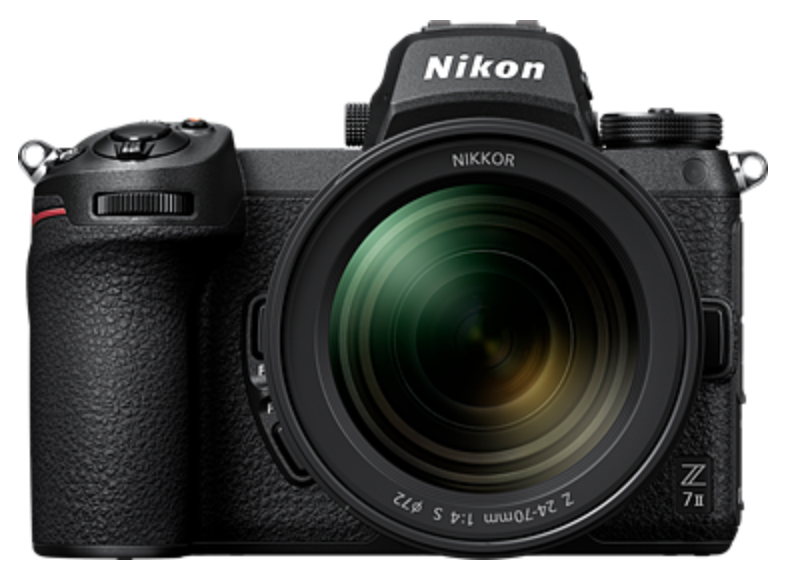
Nikon released its Z series of full frame mirrorless cameras ahead of Canon which are the Z6 and Z7 and they are quite amazing cameras except for the fact they do not come with a dual card slot which can be a disappointment for photographers who require them. The Z6 and Z7 are now replaced by the Z6 II and Z7 II which were announced in October 2020.
The Z6 II comes with a 24.5 mp sensor, shoots at 14 fps and has a 273 points AF system whereas the Z7 II comes with a 45.7 mp sensor, 493 points AF system, no AA filter, sensor shift image stabilisation, 10fps continuous shooting and 4K video recording. So these cameras will be great to shoot sports and other fast moving subjects like wildlife. The image and video quality from these cameras are brilliant.
New in the series is the entry level full frame Z5 which is compact and good for travel photography. It has a 24.3 mp sensor, and can shoot at 4.5fps continuous shooting.
These cameras come with a new Z mount that has already a few lenses available with many more coming into the market over the following years. Anyone who has owned Nikon DSLR cameras previously can mount their old lenses with any lens focal length on to these mirrorless bodies with the help of adapters designed by Nikon for these cameras.
Thoughts
With the improvements being still made by Canon in their full frame mirrorless range Nikon with the already brilliant features like focus bracketing, focus stacking, eye tracking focus, 2 card slots, continuous shooting mode, better battery life, stands out to be the best for full frame mirrorless cameras.
Other Basic Features
Lenses
Canon and Nikon come with a huge range of their own lenses and there are a lot of third party manufacturers who manufacture lenses for both camera brands if you are interested in different specifications or cheaper options.

Nikon has been developing optics since the late 1910s and Nikon's AF-S lenses developed during the 80s have autofocus, but the ones manufactured before that were all manual focus but they will still work perfectly well on all DSLRs and will need manual focusing. Also some of Nikon's entry level DSLRs do not come with an internal autofocusing motor which means some older AF-S lenses will need to be manually focused in these DSLRs. Nikon's kit lenses are far superior in quality compared to the Canon kits.
For Canon, all their EOS lenses have autofocus since development started pretty late in the 80s. Canon has the autofocus motors in the lenses and not the bodies.
However, both Canon and Nikon have a huge range of lenses for all types of photography.
Sensors
Canon and Nikon both have excellent image quality although they look different and the colours produced are noticeably different. Nikon's new sensors come without the optical low pass filter whereas most of Canon DSLRs still used them.

Performance
When it comes to performance there are various factors in a camera that can contribute to a camera’s performance. For example, autofocus, burst rate, etc.
Autofocus Speed
Considering the Autofocus speed of Canon and Nikon, both stand at almost the same level with not much difference. Some Canon cameras tend to have better autofocusing speed compared to Nikon especially with Canon's dual pixel autofocus feature.
Burst Rate
When it comes to comparing burst rates in DSLRs, Canon wins with its faster burst rates for DSLRs. Canon cameras tend to have slightly higher burst rate in some of their high end cameras. Otherwise, both manufacturers seem to be the same in terms of continuous shooting.
Comparing crop sensor bodies – Canon 7D Mark II has a 10 fps burst rate whereas the Nikon D7500 comes with an 8 fps burst rate. If you opt for an expensive D500, then you get the 10 fps burst rate.
Comparing the high end advanced cameras, the Canon 1D X Mark III comes with a burst rate of 16 fps whereas the Nikon D6 comes with a 14 fps burst rate.
Battery Life
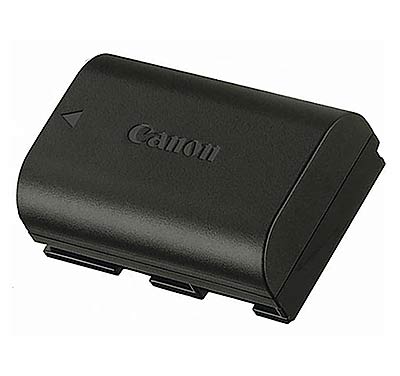
There seems to be a significant difference in battery life between the Canon and Nikon cameras. Almost all of Nikon’s DSLRs come with excellent battery life (more shots on a single charge), with some DSLR camera batteries having almost double the battery life of a Canon DSLR with similar features and price range. There are some Canon cameras with excellent battery life, but overall Nikon wins.
Astrophotography Camera
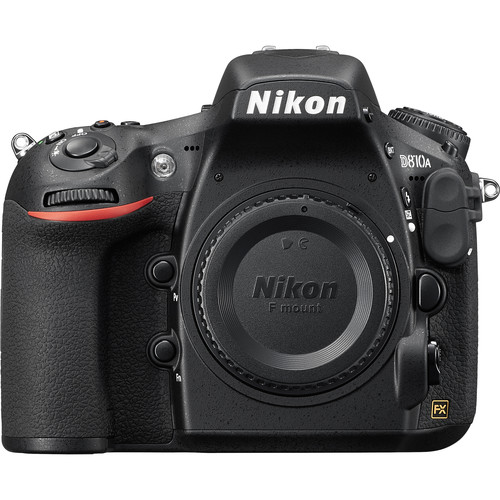
Nikon has a very good dedicated astrophotography camera the Nikon D810A which is full frame whereas the Canon's astrophotography camera Canon EOS Ra is an APS-C mirrorless camera.
Video Quality
When it comes to video quality, Canon with their hybrid autofocus system and better autofocus tracking win because it lets the camera refocus while recording. Moreover Canon has a range of lenses specifically for video.That doesn’t mean that Nikon does not offer this option as their latest range of DSLRs come with continuous autofocus tracking feature that can shoot at 60 fps. The mirrorless series are even better with varied options for video shooting.
Some Similarities In General
The image quality of both cameras are great but will not be the same if a side by side comparison is done.
If you look at colours both the cameras produce, both cameras produce brilliant colours but not the same. The colours produced by Canon are different from the colours produced by Nikon under the same lighting conditions and camera settings, but which one is better depends on personal preference and cannot be judged.
Some Differences In General
Most of the latest DSLRs from Nikon come without an optical low pass filter that helps reduce distortion and moiré in lines and patterns. Removal of this filter also results in better image quality in general.
Canon has just a camera or two that come without the optical low pass filter.
In general, both the cameras have their own advantages and disadvantages and there are certain features that are better in each camera.

Conclusion
When it comes to entry level cameras, Nikon has more to offer in terms of newer models and even affordable DSLRs with great specifications compared to Canon. While comparing performances and battery life in entry level and mid range DSLRs, Nikon has more to offer compared to Canon. When it comes to high end and/or pro level cameras, we think both manufacturers offer almost the same specs with some features like burst mode and video recording being slightly better in Canon cameras.
So, which camera brand is the best? Canon or Nikon?
To be honest, there is no winner. Both offer cameras with amazing specifications and performance with a huge range of lenses. Both manufacturers have cameras that suit all levels of photographers from beginners to professionals and hence the reason they are still in the market running their businesses.
They both have their own strengths and weaknesses and common features. Nikon cameras have better iso performance while Canon cameras have good video recording capabilities.
Choosing a camera depends on each individual and here are some things to keep in mind before deciding on which brand to go for:
- Compare both cameras and test them if possible. See how the cameras feel in your hand, look through the menu to see which one suits you better.
- Think about what features are more important for you depending on what purpose you will be using the camera for – for example, speed, image quality, purpose (astro, sports, wildlife, etc.), videos, and so on.
- Look at your budget and experience level and see what each brand has in offer for you.
- Look for features that you may require in the future and see which brand offers that for you or at the price range you are looking for.
- Do not forget to look at the range of lenses that each brand offers and see if there are lenses that you will want to add to your kit in the future.

Choosing a brand is not an easy task as there are so many things to look into before making the final decision. Research a lot, speak to experienced users, visit stores, look for reviews online, hold the camera and try a few test shots if a store allows you to do that.
What is your opinion on the everlasting Canon vs Nikon debate? Please leave your thoughts in the comments section below!
Further Resources:
- Is The Canon/Nikon Dominance Over For Professional Photography?
- Canon and Nikon’s Rivalry Heats Up in the Full-Frame Mirrorless Space
- DSLR vs. Mirrorless: There is No Debate to Settle
- Canon vs. Nikon for Astrophotography
- CANON VS. NIKON – HERE’S HOW TO MAKE YOUR CHOICE!
- Canon Vs. Nikon – Who is the best and does it matter




